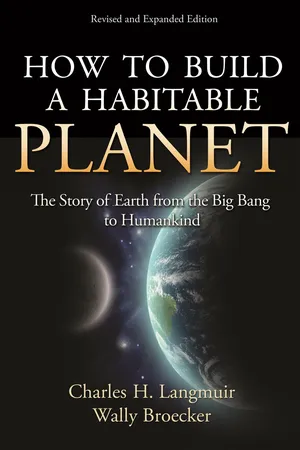
How to Build a Habitable Planet
The Story of Earth from the Big Bang to Humankind - Revised and Expanded Edition
- 736 pages
- English
- ePUB (mobile friendly)
- Available on iOS & Android
How to Build a Habitable Planet
The Story of Earth from the Big Bang to Humankind - Revised and Expanded Edition
About this book
A classic introduction to the story of Earth's origin and evolution—revised and expanded for the twenty-first century
Since its first publication more than twenty-five years ago, How to Build a Habitable Planet has established a legendary reputation as an accessible yet scientifically impeccable introduction to the origin and evolution of Earth, from the Big Bang through the rise of human civilization. This classic account of how our habitable planet was assembled from the stuff of stars introduced readers to planetary, Earth, and climate science by way of a fascinating narrative. Now this great book has been made even better. Harvard geochemist Charles Langmuir has worked closely with the original author, Wally Broecker, one of the world's leading Earth scientists, to revise and expand the book for a new generation of readers for whom active planetary stewardship is becoming imperative.
Interweaving physics, astronomy, chemistry, geology, and biology, this sweeping account tells Earth's complete story, from the synthesis of chemical elements in stars, to the formation of the Solar System, to the evolution of a habitable climate on Earth, to the origin of life and humankind. The book also addresses the search for other habitable worlds in the Milky Way and contemplates whether Earth will remain habitable as our influence on global climate grows. It concludes by considering the ways in which humankind can sustain Earth's habitability and perhaps even participate in further planetary evolution.
Like no other book, How to Build a Habitable Planet provides an understanding of Earth in its broadest context, as well as a greater appreciation of its possibly rare ability to sustain life over geologic time.
Leading schools that have ordered, recommended for reading, or adopted this book for course use:
- Arizona State University
- Brooklyn College CUNY
- Columbia University
- Cornell University
- ETH Zurich
- Georgia Institute of Technology
- Harvard University
- Johns Hopkins University
- Luther College
- Northwestern University
- Ohio State University
- Oxford Brookes University
- Pan American University
- Rutgers University
- State University of New York at Binghamton
- Texas A&M University
- Trinity College Dublin
- University of Bristol
- University of California-Los Angeles
- University of Cambridge
- University Of Chicago
- University of Colorado at Boulder
- University of Glasgow
- University of Leicester
- University of Maine, Farmington
- University of Michigan
- University of North Carolina at Chapel Hill
- University of North Georgia
- University of Nottingham
- University of Oregon
- University of Oxford
- University of Portsmouth
- University of Southampton
- University of Ulster
- University of Victoria
- University of Wyoming
- Western Kentucky University
- Yale University
Frequently asked questions
- Essential is ideal for learners and professionals who enjoy exploring a wide range of subjects. Access the Essential Library with 800,000+ trusted titles and best-sellers across business, personal growth, and the humanities. Includes unlimited reading time and Standard Read Aloud voice.
- Complete: Perfect for advanced learners and researchers needing full, unrestricted access. Unlock 1.4M+ books across hundreds of subjects, including academic and specialized titles. The Complete Plan also includes advanced features like Premium Read Aloud and Research Assistant.
Please note we cannot support devices running on iOS 13 and Android 7 or earlier. Learn more about using the app.
Information
Table of contents
- Cover Page
- Title Page
- Copyright Page
- Contents
- Preface
- Chapter 1. Introduction: Earth and Life as Natural Systems
- Chapter 2. The Setting: The Big Bang and Galaxy Formation
- Chapter 3. The Raw Material: Synthesis of Elements in Stars
- Chapter 4. Preliminary Fabrication: Formation of Organic and Inorganic Molecules
- Chapter 5. The Heavy Construction: The Formation of Planets and Moons from a Solar Nebula
- Chapter 6. The Schedule: Quantifying the Timescale with Radionuclides
- Chapter 7. Interior Modifications: Segregation into Core, Mantle, Crust, Ocean, and Atmosphere
- Chapter 8. Contending with the Neighbors: Moons, Asteroids, Comets, and Impacts
- Chapter 9. Making It Comfortable: Running Water, Temperature Control, and Sun Protection
- Chapter 10. Establishing the Circulation: Plate Tectonics
- Chapter 11. Internal Circulation: Mantle Convection and Its Relationship to the Surface
- Chapter 12. Linking the Layers: Solid Earth, Liquid Ocean, and Gaseous Atmosphere
- Chapter 13. Colonizing the Surface: The Origin of Life as a Planetary Process
- Chapter 14. Dealing with the Competition: The Roles of Evolution and Extinction in Creating the Diversity of Life
- Chapter 15. Energizing the Surface: Coevolution of Life and Planet to Create a Planetary Fuel Cell
- Chapter 16. Exterior Modifications: The Record of Oxidation of the Planetary Surface
- Chapter 17. Planetary Evolution: The Importance of Catastrophes and the Question of Directionality
- Chapter 18. Coping with the Weather: Causes and Consequences of Naturally Induced Climate Change
- Chapter 19. The Rise of Homo Sapiens: Access to Earth’s Treasure Chest Permits a Planetary Takeover
- Chapter 20. Mankind at the Helm: Human Civilization in a Planetary Context
- Chapter 21. Are We Alone? The Question of Habitability in the Universe
- Glossary
- Index